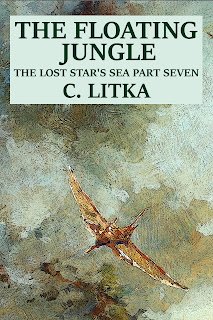 |
| image credit: https://www.tor.com/2017/09/14/cover-reveals-mary-robinette-kowal-lady-astronaut-books/ |
This is another entry in my series of remarks and observations directed at the clouds – which is to say, an opinion piece.
Having joined the Tor.com ebook club, I am occasionally offered a free ebook, usually titles that they are using to promote the release of a new sequel and such. The Murderbot novellas were such books, as were a number of mostly fantasy novels and novellas, which I sampled, and did not get past the first page, or chapter. The most recent free book is The Calculating Stars, by Mary Robinette Kowal. Kowal’s novel winner of the 2018 Nebula Award for Best Novel, the 2019 Locus Award for Best Novel, the 2019 Hugo Award for Best Novel, and the 2019 Campbell Memorial Award. Since the price was right, the book is speculative fiction rather than fantasy, and very highly regarded, I eagerly downloaded my ebook copy and dived into it.
The book is an alternative history of the American space program of the 1960’s. In this story, an asteroid strikes the east coast in 1952, triggering an extinction event. An accelerated space program is launched that echoes the actual 1960’s program, but with the aim of establishing colonies on the Moon and Mars before the earth becomes uninhabitable. Its premise is a classic speculative fiction story. Fred Hoyle’s The Black Cloud coming immediately to my mind.
It did not, however, click with me. I found myself, at the halfway point, skimming through the book in the hopes of just getting it done. Not good. Realizing this, I called it a day. I’m not one who feels obliged to finish a book I don’t care for. After giving The Calculating Stars half a book to hook me, I couldn’t find a reason to continue.
Having read only half the book, I can’t really review it. But I will share my thoughts about the first half, just between you, me, and the clouds.
In many ways, The Calculating Stars should’ve clicked with me. I prefer first person narratives. The story is one. I prefer smaller stories. The first half of the story, anyway, is not grandiose. I like to spend my reading time with pleasant characters. The supporting characters are, for the most part, likable, though I confess to having lost track of them, given the very episodic nature of the story structure. Given that my stories are episodic in nature, that too, should not have been a problem. So it had a lot of things going for it. But…
Thinking about it, I think there are two aspects of The Calculating Stars that failed to click with me – the narrator and the premise.
I’ll start with the narrator, Elma York. She was born in Charleston SC in the early 1920’s, the daughter of an army officer, eventually a general. He taught or encouraged her to take up flying. During World War Two she was one of the group of female pilots who flew airplanes from factories and bases to other bases, freeing men for combat duty. She is a mathematical genius, earning a PhD in mathematics and physics, at some point. She is happily married to another PhD, a well known rocket scientist. At the start of the story, she is working in the government bureau, the National Advisory Committee for Aeronautics doing computations. She has emotional scars from her college years, when she was called to the head of the class and made to shame the male students with her ability to do math in her head that they had trouble doing on paper. This seems to have given her a great fear of calling any attention to herself – at least that is how I read it.
The problems I have with her is, first, both she, and her husband, are comfortable ignoring the fact that she’s a PhD. She’s known simply as Mrs. York (rather than Dr. York) and despite her brilliance, works in a fairly menial capacity, presumably because that’s all women were allowed to do. Yet, I find it hard to imagine that any woman of her accomplishments, even in 1952, would have settled for this situation, especially someone with her bravery and determination. While she is not quite content with her status, she wants to be an astronaut, she doesn’t really ever stand up for herself, nor, for that matter does her husband. Secondly, growing up in the south of the 1920’s and 30’s, in the household of a fairly important army officer, I would think that they would’ve had a black servant or two – a cook, a maid, a nanny, and certainly yardmen and such. She would’ve been familiar with blacks, and would’ve had a definite opinion of them, one way or the other. She is, however, written as if she grew up in Lake Wobegon, Minnesota. She treats the black characters as if she is first meeting black people, and their lives are a mystery. Race relations is touched on in the story, but tiptoed around. Her treatment of them, as a southerner just didn’t feel authentic. And lastly, despite her accomplishments, she comes off as rather needy… She simply doesn’t make sense to me, at least in the first half of the book – which is probably due to me being clueless. Perhaps these issues are resolved by the end of the book, but in the first half, she never struck me as being the person she would have needed to be to have achieved what she achieved. I found it hard to relate to her, and the often mundane nature of the story she relates.
I lived through the 1950’s & 60’s, and in reading this story I never experienced even a glimmer of recognition for the time period. The same can be said for the setting and larger backdrop of the times. The backdrop of the post-asteroid world is merely hinted at with a quoted news story at the beginning of the chapters. “Mrs York” doesn’t relate much beyond her immediate concerns. Indeed, even the space program, which she is part of, mostly plays out in the background. Every so often we have a rocket launch viewed from the control room, and that’s it, at least in the first half of the book. And even her focus on everyday life doesn’t seem to bring that life into context. Once you get past the premise, there’s not a whole lot of speculative fiction in this the story – at least in the first half. And that brings us to the premise.
One of the main reasons I stop reading a book is that I find something too stupid to want to continue reading. Given the praise this book has generated, I turned a blind eye to its stupid premise. But in the end, with the story just dragging along, I could no longer ignore its nonsensical premise. That premise is, that because of the greenhouse effects, due to the amount of water put into the atmosphere by the impact of the asteroid, the earth will gradually heat up and become uninhabitable. Well, okay, I’ll give that a pass. Nothing is simple, and I would suspect that there would be a lot of unknown unknowns that might mitigate the effects somewhat, but what the heck, let’s go with it. The solution to saving humanity that the story proposes, however, doesn’t get that pass. The solution we are supposed to buy is that humans need to rapidly develop rocket ships in order to use them to escape earth and set up colonies on the moon and Mars. (Another very old and familiar premise.)
But think about it. Why would we go to all the trouble of developing a space program from scratch so that we could set up self-supporting bases on harsh, faraway, airless and/or uninhabitable worlds, in order to escape our someday uninhabitable world? I mean, if you can establish self-supporting colonies millions of miles away, and only after you perfect a whole new technology just to get there, why would you not set up those same colonies here on the earth? It would be several orders of magnitude easier, far less expensive, and it would save many, many times more people than any moon colony would. I simply can not imagine that establishing a colony on the airless, radiation bombarded moon would be easier than building underground self-supporting underground shelters here on earth – near the poles if need be.
So, long story short. The premise makes no sense to me. I suppose it makes the book more dramatic, and easier to option for a movie deal. But the reality is that the story is not all that dramatic. I have to believe that a similar story could’ve been told against an alternate cold war space race against a more accomplished Soviet Union, with, perhaps, greater effect.
All art is subjective. I don’t write criticisms. I write how stories, TV shows, and art strike me. This story, despite my best efforts, just didn’t appeal to me. Things about it just seemed off. I found that I could not relate to the narrator. It failed to make me suspend my disbelief. And well, the premise is silly. That said, I recognize that this book has much to say about the struggle for equality, something that should be said. I’m glad it found an audience.

































